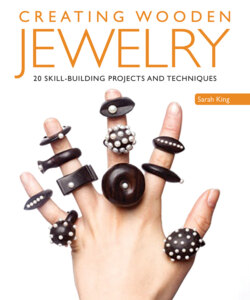Читать книгу Creating Wooden Jewelry - Sarah King - Страница 8
На сайте Литреса книга снята с продажи.
The use of wood in jewelry
ОглавлениеThe new movement in jewelry in the 1970s questioned traditional values—the nature of preciousness and of jewelry as a symbol of wealth and status. With that came experimentation in techniques and a greater use of non-precious materials such as wood, acrylic, aluminum, and textiles. Influential figures within education in West Germany, Holland, and the UK were part of this movement, and new galleries opened to exhibit this new approach. American jewelers often had a more individualistic, narrative approach compared to European designers. Bruce Metcalf epitomizes this genre, and he continues to work in a wide range of materials including wood. Another key figure of the American scene was Marjorie Schick, whose striking “body sculptures” were constructed from painted wood elements.
Heart-shaped pin by Korean jewe er Dongchun Lee.
It was within this atmosphere that Norwegian Liv Blåvarp started experimenting with laminated wood at the Royal College of Art in London in the 1980s, before returning to Norway where her work developed into smaller carved pieces joined together to have greater flexibility around the body. She is inspired by the Native American way of expressing feelings about nature. Some of her imagery is reminiscent of birds and animal anatomy. In her later work, there is a dynamic between internal and external forms, and all her pieces have integral solutions for their clasps.
Dutch jeweler Francis Willemstijn takes a poetic approach to materials that have historical resonance and personal significance. She used bog oak in her Heritage collection to make pieces reminiscent of memento mori, as bog oak was used in the 19th century as a substitute for jet. On a larger scale, British woodturner Eleanor Lakelin emphasizes the rhythm of growth, the eroding power of the elements, and the passing of time in her work. German jeweler Jasmin Matzakow has compared trees to humans, in that both have joints, skin/bark, and the ability for growth. Wood has been her primary material to explore jewelry, the body, and the social context of both, and she has gravitated toward woods closer to European traditions such as linden and spruce.
Other jewelers manipulate the physical properties of wood, for instance Dane Mette Jensen’s steam-bent work and Japanese jeweler Manami Aoki’s fiberized pieces. In recent years, digital technologies have been used for producing work, with British designer Anthony Roussel making early use of lasers for his laser-cut pieces. So the reasoning behind the choice of wood as a material for jewelry and the methods of its production continues to be very diverse.
Where the Daisies Grow, necklace in wood by Liv Blåvarp.
